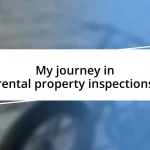Key takeaways:
- Understanding the maintenance request process is crucial for efficiency, involving steps like prioritization based on urgency and potential impact.
- Establishing a tracking system using dedicated software enhances organization, streamlines workflows, and empowers team collaboration.
- Clear communication and setting response timelines foster tenant trust and satisfaction, transforming routine interactions into meaningful connections.

Understanding maintenance requests process
When I first started handling maintenance requests, I quickly realized that understanding the process was essential for efficiency. Each request involves various steps: identification, prioritization, execution, and follow-up. Have you ever felt overwhelmed when an urgent request comes in unexpectedly? It’s in these moments that knowing how to navigate the system can make all the difference.
As I dove deeper into this process, I learned how crucial it is to categorize requests based on urgency and impact. For instance, a leaking pipe demands immediate attention. In contrast, a request for a paint touch-up can wait a bit. Recognizing these differences not only streamlines the workload but also enhances tenant satisfaction. It feels rewarding when residents thank you for prompt service, doesn’t it?
Having an organized tracking system has transformed the way I manage requests. I remember implementing a simple software tool, and it was like a light bulb went off. Suddenly, I could see all requests in one place, prioritize them effectively, and even set reminders for follow-ups. It’s remarkable how a little organization can lead to happy residents and a smoother operation! What tools do you find useful in your maintenance processes?

Identifying common maintenance issues
Identifying common maintenance issues requires keen observation and experience. Over the years, I’ve noticed that some problems crop up more frequently than others. For example, plumbing issues typically rank high on the list, often because they can quickly escalate, resulting in water damage if neglected. I can recall when a slight leak turned into a weekend emergency because it was overlooked – a lesson learned the hard way!
Alongside plumbing, electrical problems are another common issue that needs immediate attention. After a few instances of residents reporting flickering lights, I decided to conduct routine checks, which uncovered wiring issues that could have escalated. This proactive approach not only prevented potential hazards but also instilled confidence in the residents. It’s empowering to tackle issues before they become major headaches, wouldn’t you agree?
Lastly, appliances breaking down is another prevalent maintenance concern, especially in multi-family units. I’ve found that by equipping residents with easy troubleshooting tips, many minor problems can be resolved quickly. For example, I’ve created a simple guide on how to reset commonly used appliances, which not only reduced incoming requests but also fostered a sense of community. It feels gratifying to empower residents in this way and reduce the maintenance workload simultaneously.
| Common Issue | Typical Urgency |
|---|---|
| Plumbing Issues | High |
| Electrical Problems | High |
| Appliance Breakdowns | Medium |

Setting up a tracking system
Setting up a tracking system for maintenance requests changed the way I approached my role entirely. Initially, I used a simple spreadsheet, but soon I realized that just tracking requests wasn’t enough. I needed a more dynamic system to boost my efficiency and enhance resident satisfaction. When I switched to a dedicated maintenance management software, everything fell into place. The clarity and organization it provided were game-changers, relieving much of the stress I used to feel juggling various issues.
Here’s how I set it up effectively:
-
Centralized Dashboard: This allows me to view all incoming requests at a glance, prioritizing based on urgency and type.
-
Automated Alerts: Setting up reminders for follow-ups ensures nothing falls through the cracks, transforming my usual chaos into a manageable workflow.
-
Categorization: I can easily categorize requests—whether plumbing, electrical, or appliances—which makes it simple to visualize trends and prepare for upcoming issues.
-
Resident Feedback: Incorporating a feedback mechanism helps me gauge satisfaction post-resolution, so I can continuously improve my processes.
Switching to this system was not just about technology; I remember the moment it clicked for my team too. They weren’t just waiting for me to assign requests anymore; they could take initiative and see what needed attention right away. That collaboration felt like a breath of fresh air – one where everyone knew their roles and felt empowered to contribute. Seeing my team take pride in their work truly changed the atmosphere of our entire operation.

Prioritizing requests effectively
When prioritizing maintenance requests, I often reflect on the impact of urgency on residents’ lives. I’ve learned that not all issues are created equal; a leaky faucet won’t garner the immediate concern that a flooded basement will. One particularly memorable incident involved a tenant unable to access their unit due to a broken door lock. It hit home for me how essential it is to address security concerns first and foremost, as the sense of safety in one’s home is paramount.
Basing my priorities on a combination of urgency and potential impact has proven effective. For instance, while working through a list of requests one day, I found myself confronted with three plumbing issues simultaneously. Rather than treating them all equally, I assessed which one posed greater risk of damage and, thus, prioritized resolving it first. That day, balancing urgency with potential fallout felt like a juggling act; I was grateful to have developed my prioritization skills over time.
I’ve also learned the value of communication in this process. After implementing a system whereby residents indicate the urgency of their requests, I found that it filled in the gaps in my understanding. For example, when a resident marked their request as “urgent,” I could immediately address it while providing empathy and reassurance. Isn’t it great how a simple question can transform the entire response process? In reflecting on these techniques, I encourage anyone handling maintenance requests to lean into empathy and communication—it makes all the difference.

Communicating with tenants clearly
Clear communication with tenants is an essential aspect of efficiently handling maintenance requests. I’ve found that being straightforward yet friendly can make a huge difference. One time, I received a maintenance request from a tenant who was understandably frustrated about ongoing plumbing issues. Instead of providing a generic response, I took a moment to acknowledge their feelings and assure them that I was on it. A simple “I understand this is inconvenient for you, and I’m here to help” transformed their frustration into patience, reinforcing trust in our responses.
I’ve also learned that utilizing multiple channels to communicate enhances clarity. I often use a mix of texts, emails, and phone calls to keep tenants in the loop about their requests. For instance, after a technician finished repairs, I’d shoot a quick message to the tenant confirming the job was done and asking if everything was satisfactory. Engaging in this way not only kept everyone informed but also created opportunities for tenants to voice any lingering concerns. Have you ever noticed how much smoother interactions become when people feel they can speak up?
Finally, being proactive about updates is crucial. I remember a time when a significant repair took longer than expected. Instead of waiting for tenants to inquire, I reached out to them with an update. They appreciated the transparency, and this prevented any frustration from building. When tenants feel they’re kept in the loop, it fosters a sense of partnership rather than a landlord-tenant divide. Communicating clearly isn’t just about words; it’s about building relationships.

Establishing a response timeline
Establishing a response timeline is vital to ensure that tenants feel heard and valued. I remember a time when I faced a flood of maintenance requests after a storm. Realizing how overwhelming this was for both me and the residents, I quickly established a timeline for responses that prioritized safety and urgency. This simple structure not only calmed my nerves but also reassured tenants that their concerns were on my radar.
What I’ve found particularly enlightening is that having a clear timeline sets expectations for everyone involved. For instance, I used to feel guilty if I didn’t respond to requests right away, but once I created a response timeline, I realized that giving tenants a timeframe helped manage their expectations. And to my surprise, this fostered patience. Isn’t it incredible how a little organization can lead to such a profound shift in perspective?
Incorporating feedback from residents has also enriched my approach. After implementing the timeline, I reached out to a few tenants to gauge their thoughts on my responsiveness. One tenant shared that knowing I would respond within 24 hours, even just to acknowledge receipt of their request, eased their worries. It made me appreciate how essential it is to not only establish a timeline but also to adjust it based on real conversations. I’d say it’s a vital lesson: responding thoughtfully can transform a routine request into a meaningful interaction.

Reviewing and improving processes
When I reflect on the processes for handling maintenance requests, I can’t help but think about the importance of reviewing them regularly. I recall a particular situation where our request handling was quite clunky, leading to delays and tenant dissatisfaction. After some self-reflection and feedback, I decided to sit down and analyze the entire process, identifying bottlenecks. This review not only improved efficiency but also gave me peace of mind, knowing we were creating a smoother journey for our residents. Isn’t it amazing how taking the time to step back can reveal so much?
Improving processes is also about staying flexible and open to change. For instance, I once implemented a new maintenance tracking software that I thought would streamline requests significantly. However, after a few months, I noticed it was causing more confusion than clarity for both my team and the tenants. Instead of sticking stubbornly to it, I gathered everyone’s feedback and we reverted to a simpler method, which restored comfort and efficiency. Have you ever pushed for a change only to realize it wasn’t working? Learning to pivot based on real experiences is a crucial step in refining how I operate.
Fostering a culture of continuous improvement has highlighted the value of collaboration. I frequently hold informal meetings with my maintenance team to discuss what’s working and where we can do better. One memorable instance involved us brainstorming ways to simplify communication during repairs. Through open discussion, we identified a few key phrases to use when updating tenants, which not only clarified our messages but also conveyed empathy. I’d say that embracing a collaborative mindset is pivotal—not just for improving processes, but also for strengthening our overall community bond. What have you learned from engaging with your team or your tenants?














